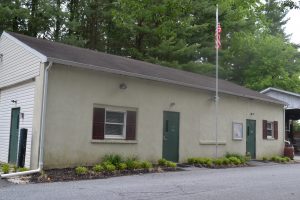During a packed supervisors’ meeting on Monday, June 8 – held in what most residents deem a substandard Pocopson Township building – the Barnard House, a historic landmark undergoing renovations to replace it, got back on track.

After listening to a half-hour presentation prepared by the Barnard House Steering Committee, remarks from architect Dennis Melton, and more than 30 comments from residents and non-residents, Supervisor Georgia Brutscher, who chairs the steering committee, and Supervisors’ Chairman Barney Leonard, voted to approve the next step in the project: the Phase Two Scope of Work.
The 2-1 vote will pave the way for preparing bids for work inside the building, a former way station for escaping slaves in the Underground Railroad movement; the bulk of the exterior work has been completed. During two previous meetings, Leonard and Supervisor Ricki Stumpo both voted to table the measure, identifying concerns about the building’s security and functionality.
Before the vote, Stumpo reiterated her misgivings, questioning the wisdom of moving forward when key issues regarding safety and efficiency have yet to be addressed. Like others who expressed reservations about advancing the project, Stumpo said she supports preserving the historic building.
“This is about where we need our township facilities,” she said, referencing two studies that suggested the space was ill-suited to the township’s administrative needs. “I think we need to look at other options.” She also noted concerns about cost, explaining that the last phase of the project included $35,000 in overruns.
Leonard emphasized that Monday night’s vote did not give a green light to the interior work, but rather approved the work needed in advance of it. According to a proposal submitted by Melton, his work will not exceed $13,000; however, an additional $6,800 will go to DEDC, LLC, a Delaware-based engineering and design firm, township records said.
After the meeting, Leonard said his position has not changed; he said he received more information about the process through discussions with Melton. Leonard said the clarifications he still seeks should be addressed in what he termed “specification exercises” during the Phase Two Scope of Work process.
He said Melton would meet with the staff to discuss the layout. “We have the ability to shift things around,” Leonard said.
During a half-hour slide presentation, Lauressa McNemar, a member of the Barnard House Steering Committee, presented an overview of the project, which dates back to the 1970s when township officials began searching for a new township building. The township assumed ownership of Barnard House and its surrounding 68 acres from Chester County in 2008 for $1 with the goal of preserving it for use as a township building, public meeting space, and a home for the Kennett Underground Railroad Museum.
McNemar said that the exterior work is nearing completion and that the committee anticipates the interior work would be finished in 2016. At that point, the township could consider adding a large meeting room at an estimated cost of $255,000; it was eliminated from the current plan for financial reasons. The cost to the township for the past seven years has been $528,340, McNemar said.
The estimate to complete phase two is $650,000, which would be financed through a 20-year, $750,000 loan, an expense included in the 2015 budget. McNemar estimated the total cost of the project at $1.25 million.
“Can we afford this?” McNemar asked. “Yes, we are in excellent financial shape.”
Melton added that he believes the building is “well-suited to the needs described” by the township. But he said some issues would be revisited for confirmation and updates. He said he read the other studies suggesting that the space didn’t work and “was a bit disappointed” because they did not contain useful information.
“The space planner was not looking at this in a broad enough way,” he said.
Most of the residents who spoke in favor of advancing the project cited the building’s historic significance. E. Barnard Baily, patriarch of Baily’s Dairy, said that while he doesn’t favor tax increases, he believes preserving the historic home represents a great opportunity. “We deserve better than this garage,” he said, referencing the current township building.
Jean Conary, a member of the steering committee, described the Barnard House as precious for the township as well as the county. “How can we deny the repurposing of it?” she asked.
But those who opposed the vote to move forward all said they favored preserving Barnard House; however, they questioned whether trying to cram a township building into it served everyone’s best interests. Several suggested that the issue should be put on the ballot, giving the residents who would be paying for it a voice in deciding the building’s fate.
One of them, Mike Mulholland, likened the township’s acquisition of the house to being given a free horse, which then has to be maintained. “Be careful of what you take for free; you’ll pay the rest of your life,” he warned.
Randy Mims pointed out that the approximately 60 people who attended last night’s meeting wouldn’t fit into the proposed new facility. “It’s not an efficient township building,” he said, urging the township to consider other options.
The majority of the non-residents who spoke were affiliated with the Kennett Underground Railroad Center. Chris Densmore, a Pennsbury resident, said lots of places claim participation in the Underground Railroad, but evidence substantiates the role of Barnard House. “You guys have got the absolute real thing,” he said. He suggested that the best way to preserve such a resource is to establish a use for it.
After the meeting, Brutscher said the presentation should have included more information about the future cost to the township. With an interest rate of 2.604 over 20 years, the loan for the Barnard House will require the same payment – about $49,000 per year – as the township’s previous projects for parks and public works. Those are now paid off. “It will be same thing we’ve been paying,” Brutscher said.
In other business on Monday night, the supervisors agreed to start posting information about Pocopson’s Right-to-Know requests on the township’s web site. Entries would include the date of the request, the requestor, the time and cost to process the request, and the documentation it generated. Leonard said the idea came from the Pennsylvania State Association of Township Supervisors’ conference.
Leonard said many commercial entities are using the process to gather data that they should be compiling at their own expense. He said townships that started posting the information saw a decrease in frivolous Right-to-Knows. He added that the process increases transparency and also shows residents “how much unfunded mandates cost.”
At Stumpo’s urging, the policy will be revisited after six months to determine whether it proves burdensome for township employees.


The comments made by the respondent raise a number of questions over what was promised vs. what has been done. None of the grants received so far have been for the Banard House. They were all for the park, and the township is bending the rules to utilize them for their goal of finishing the Banard House at any cost. That is why they have a park bathroom attached to the Banard House, and it must be open for all of the public from sun up to sun down. Furthermore, the prison has no authority to order visitors not to use the park or its bathroom facilities. The park is open to the public, and state monies were used to build those bathrooms.
Two of the township supervisors refuse to answer the tough questions. However, I have a very simple idea to resolve this issue once and for all. Allow it to be placed on the ballot for the election this fall, and let the chips fall where they may. To continue the current status quo is just wrong.